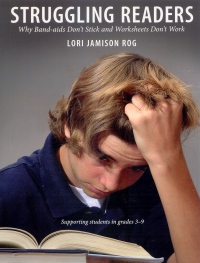| ________________
CM . . . . Volume XX Number 33 . . . . April 25, 2014
excerpt:
In Rog's previous book, Guiding Readers: Making the Most of the 18 Minute Guided Reading Lesson, Rog explored how teachers can help struggling readers using small group instruction. That book, however, generally focused on younger students (with only one chapter dedicated to older students), and Rog's readers wanted to know more about how to help older students who are having difficulty with texts. Taking up this call from junior and intermediate level teachers, Rog has written a new book entitled, Struggling Readers: Why Band-aids Don't Stick and Worksheets Don't Work, which is completely dedicated to helping struggling readers in Grades 3-9. Struggling Readers: Why Band-aids Don't Stick and Worksheets Don't Work consists of 10 chapters. The topics for the chapters include: assessment and selecting texts, small group instruction, sustained silent reading, comprehension strategies, working with words, fluency, nonfiction, digital literacy, and writing about reading. The chapters are structured with an explanation of the topic, what the research says about struggling readers, and then explicit teaching strategies to help readers reinforce these concepts. Included in the chapters are specific ideas for lessons, as well as blackline masters and anchor charts. At the end of the introductory, chapter, there is a helpful "If/Then Chart" that teachers can use to quickly access strategies in the book to help readers. In this chart, Rog lists 12 potential issues struggling readers might face, then lists some potential strategies, and refers teachers to the specific chapter that applies to this problem. A highlight of Struggling Readers is Rog's accessible and engaging writing style. She meshes research with classroom experiences in a way that feels like you are having a conversation with her rather than reading a professional book. However, as I read the book, I did not always agree with Rog. For example, Rog does not believe that the shared reading strategy of having advanced readers follow along with their eyes as a teacher reads a text aloud (or listen to an audio book) is effective as readers cannot keep up with the fluent reading. She provides no references for these statements. I have used this shared reading technique, as described by literacy educators such as Janet Allen, with success with older elementary students. Despite any professional disagreement I might have with Rog, it would be impossible not to give Struggling Readers a good review. Struggling Readers is very comprehensive. It would be a good book for any teacher of Grades 3-9 to read for a general refresher or to be dipped into by teachers looking for strategies to help students with specific issues in reading. Because of its scope and readability, Struggling Readers would also be suitable for pre-service teachers as a course text. As I read Struggling Readers, I was struck by how explicit is it: Rog has clear and specific strategies to help struggling readers. These strategies are presented clearly in a way that is doable for a busy teacher working with the diverse needs of a classroom. Also, as the excerpt states, these strategies are good strategies for all readers. Struggling Readers is a win for everybody. Highly Recommended. Dr. Kristen Ferguson teaches literacy education at the Schulich School of Education at Nipissing University in North Bay.
To comment
on this title or this review, send mail to cm@umanitoba.ca.
Copyright © the Manitoba Library Association. Reproduction for personal
use is permitted only if this copyright notice is maintained. Any
other reproduction is prohibited without permission.
NEXT REVIEW |
TABLE OF CONTENTS FOR THIS ISSUE
- April 25, 2014.
AUTHORS |
TITLES |
MEDIA REVIEWS |
PROFILES |
BACK ISSUES |
SEARCH |
CMARCHIVE |
HOME |
